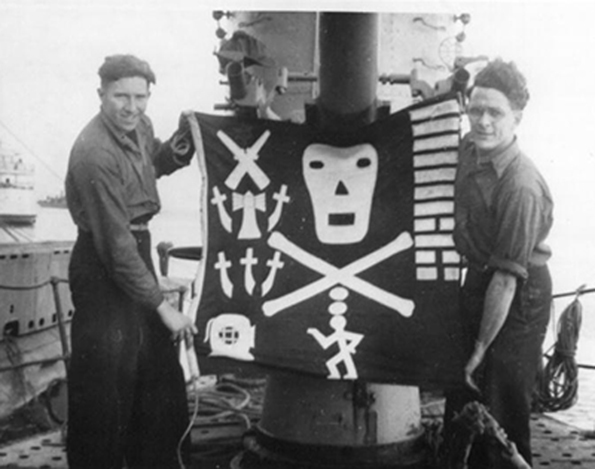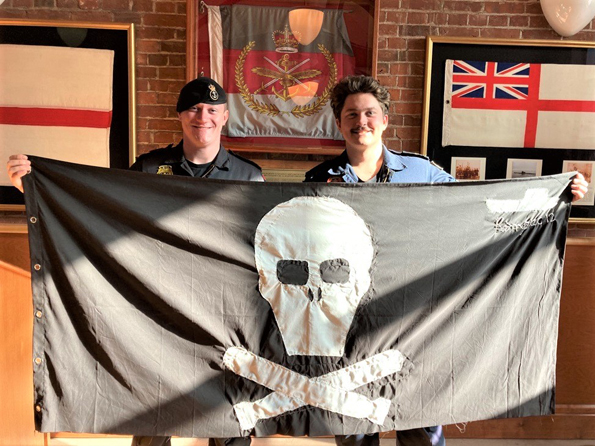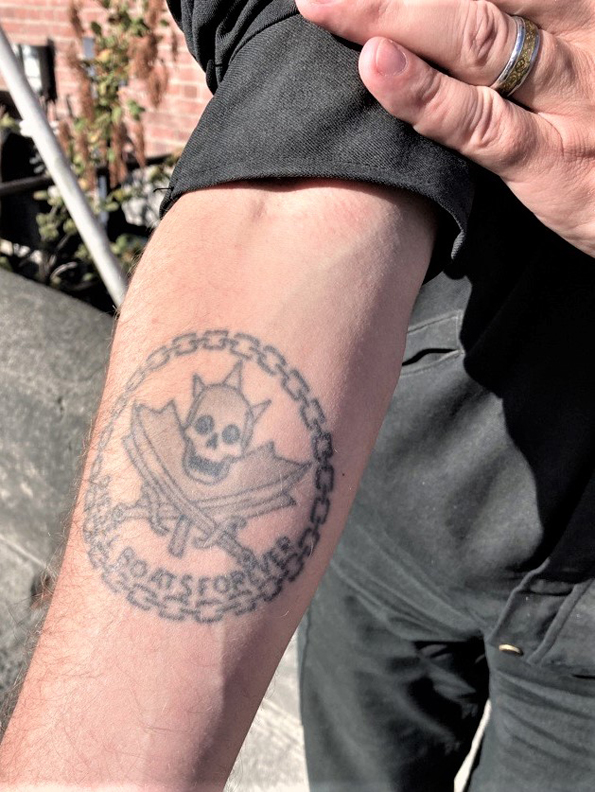Submariners: underhanded, unfair, and damned un-English?
By Lookout Production on Sep 29, 2023 with Comments 0

The Jolly Roger flown by the original HMS Unseen, photographed in Digby, N.S., in 1944. Photo credit: Submarine Association of Canada
SLt Matt Ladouceur
CANSUBFOR
‘Joli rouge’ – a sardonic label the French assigned to the flag pirates brandished when no prisoners were to be taken. The plain red flag underwent successive redesigns during the 18th century until settling on the standard we recognize today in its anglicized term ‘Jolly Roger’.
But what comes to mind when you visualize skull and crossbones? Bad things, pirates, a poison warning on a label?
What about submariners?
Few know the longstanding link between the submarine community and the Jolly Roger. As with most Royal Canadian Navy traditions, this one traces its origin to the British, more precisely, to comments made by the First Sea Lord, Admiral Sir Arthur Wilson. He referred to the advent of submarine warfare as ‘underhanded, unfair, and damned un-English’ and argued that enemy submariners should be hanged as pirates upon capture.

Sailor First Class (S1) Zack Davison and S1 Mack Crouch of CANSUBFOR display the Jolly Roger that was flown during RIMAPC 2012 from HMCS Victoria. Photo credit: DND
Of course, he wasn’t referring to Royal Navy (RN) submariners, but they delighted in the characterization and readily adopted the Jolly Roger. One of the earliest examples occurred on the morning of Sept. 13, 1914, when the RN submarine His Majesty’s Ship (HMS) E9 torpedoed and sank the German cruiser SMS Hela in the Helgoland Bight. To mark their achievement – and one suspects, to thumb their collective noses at the Admiral’s characterization – E9’s captain Lieutenant-Commander Max Horton proudly and, perhaps defiantly, flew the Jolly Roger while returning to port.
“The Jolly Roger has become a symbol associated with the Canadian and other submarine communities,” remarked Captain (Navy) Alex Kooiman, Commander Canadian Submarine Force. “It’s an emblem we identify with and helps to distinguish us. It connects us with our past, shapes our present-day culture and bolsters an esprit-de-corps that will serve us well as we journey to the future force.”
The standard Jolly Rodger underwent many submariner-specific modifications during the Second World War. RN submarines would alter their flags following successful missions using a series of coded representations. A white bar was added for sinking an enemy merchant vessel; for a warship, the bar was red. The letter ‘U’ denoted a destroyed U-boat. Clandestine operations earned a ‘dagger’. Squadron commanders could present flags, but they were customarily crafted by boat crews using material on hand. For example, the original HMS Upholder’s Jolly Roger was sewn from blackout curtains used during a port visit to Malta.

The Jolly Roger’s use continues to this day among Commonwealth navies. During the Falklands War, it appeared on HMS Conqueror following that submarine’s sinking of the Argentine Navy’s General Belgrano. More recently, the crew of HMCS Victoria hoisted the skull and crossbones to mark the successful firing of war shot Mark 48 torpedo when they sank the hulk of the USNS Concord during the multinational exercise RIMPAC in 2012.
Our Australian cousins on His Majesty’s Australian Ship Oven similarly hoisted the flag after their first live firing of a Mark 48 torpedo. It’s even been brandished by our neighbours to the south and was spotted flying from USS Jimmy Carter twice in Puget Sound in 2017, for reasons unknown.
The contemporary Canadian submarine community continues to embrace the tradition of the Jolly Roger. One may observe the iconic skull and crossbones logo adorning morale patches, in mess decor, crew merchandise and inked into the skin of many a submariner. To that small and close-knit community, the Jolly Roger is a visual identifier as unique as the submarine service.
Filed Under: Top Stories
About the Author:





